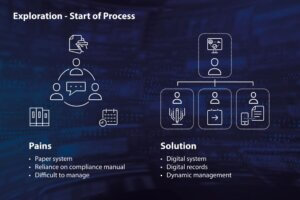At Aquachem we are always looking for new, innovative techniques in water treatment to help streamline our service, and by going “online” we can now provide this to our customers.
We use several e-services such as flex, the biosearch app, and use technology like the HASL corrosion monitor, which not only speed up the reporting process but also increases visibility, enhances customer service, and optimizes security.
By automating many tasks in routine service visits, what was once manual, labour-intensive tasks, these online solutions allow managers / building owners to refocus their resources to other needs. Managers have more resources at their disposal to address acute problems, long-term planning, and innovative strategies.
Why does going paperless matter?
Enhanced productivity
The traditional method of using paper; from recording results, logging actions and generating batch records, operators can spend a large part of their day gathering, compiling, filling and transmitting this data.
However, by embracing digital technology, operators and water technicians can eliminate this time-consuming process and the administrative hassle of physical data transmission. In turn, more time can be spent focusing on the job at hand and staff can respond quicker to urgent matters – increasing worker morale and productivity as a result.

Eliminates data inaccuracies
Data collected by routine monitoring can be used to detect any deviations from an out-of-normal situation that may threaten water quality, and the integrity of this data is paramount to avoid a scenario where data trending may be called into question.
However, the reliance on paper-based processes come with multiple risks that increase the likelihood of data errors. Not only is a large amount of pressure placed on environmental operators to maintain a consistent level of accuracy, but paper records will become illegible over time, while also having the potential to be easily lost or damaged – should this occur, professional standards and compliance processes may be contravened.
Luckily, digital transformation provides a solution to these issues. Once data has been collected, it can be promptly inputted into the system without the need for printing, transferring or ever creating the need to produce a tangible document.

Data analytics and control
Advanced software can analyze data with a level of speed and interconnectedness that is impossible with paper. Real-time data analytics alert to potential problems and highlight opportunities for improvement, so you can make smart decisions in an instant via a user-friendly dashboard. Software can also analyze historical trends to gain insights that inform a strategy of continuous improvement.
Reduced costs
When considering the costs related to running a complex facility with numerous systems, those surrounding paper-processes aren’t likely to be at the forefront of most managers’ minds, but as long as outdated processes continue to facilitate increased risk of human error, the total costs at the hands of limited digitisation have the potential to rapidly escalate.
If operators or technicians enter an incorrect figure when manually entering data into the system, it is unlikely that this mistake will be highlighted before the point of printing, if at all.
Inaccuracies may also insinuate that no action is required when reality tells quite the opposite, and company resources must then be redirected to enable operators to rectify these mistakes by repeating the entire process. This task is not only time-consuming and puts a halt to productivity, but also creates vast cost inefficiencies for the company when occurring on a regular basis.
Conclusion
Advancements in technology across various industries has proved that digital transformation is not just a passing trend, and although improvements have been made, industry leaders shouldn’t underestimate the impact of embracing paperless systems.
With a more efficient workforce, the technology would enable water companies to stay ahead of the curve and bypass competitors to establish themselves as a market leader.
Like any transition, the data and analytics journey must take place in stages. Expert support and careful planning are crucial to start laying the foundation and building buy-in throughout your organization.







